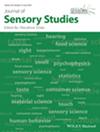This research aimed to investigate the occurrence and prevalence of possible changes in the sensory perception of individuals who presented total or partial loss of smell or taste when infected by SARS-CoV-2, comparing the results with those of individuals who were not diagnosed with the disease and did not show typical symptoms of the infection. One hundred volunteers were recruited, of whom 50 were from the group of people who had COVID-19 and had signs of smell or taste dysfunction (COVID group), and 50 were from the group of people who did not have the disease and did not show symptoms of the disease (Control group). Gustatory tests were performed to evaluate four primary tastes: sweet, salty, sour, and bitter, and olfactory tests were performed to assess odors: coffee, pineapple, lime, and cinnamon. To determine the detection and recognition thresholds, three-alternative forced-choice sessions of tastes and odors were carried out, and intensity scales were used to verify the sensory perception of the participants. Significant differences were confirmed between the groups (Control and COVID) for the detection and recognition thresholds for all tastes and odors. Sour taste was significantly affected in terms of detection and recognition, suggesting that COVID group shows lower sensitivity concerning this taste. Pineapple odor was the most difficult of being recognized by COVID group. The intensity attributed to the stimuli by the COVID group were lower than those of the Control group and differed statistically at the highest concentrations. Data show that individuals in COVID group remained with gustatory and olfactory alterations in sensitivity, detection, and recognition capacity.
This research demonstrated the prevalence of symptoms of sensory-processing disorders related to gustatory and/or olfactory functions in individuals who tested positive for COVID-19, even after been cured of the infection. They had sensory alterations in terms of detection and recognition capacity, as well as sensitivity. In practice, several factors associated with quality of life are impaired due to sensory-processing disorders, such as food, personal hygiene, safety, and physical or mental illnesses, which lead to a necessity of monitor these individuals as these factors are related to public health.


